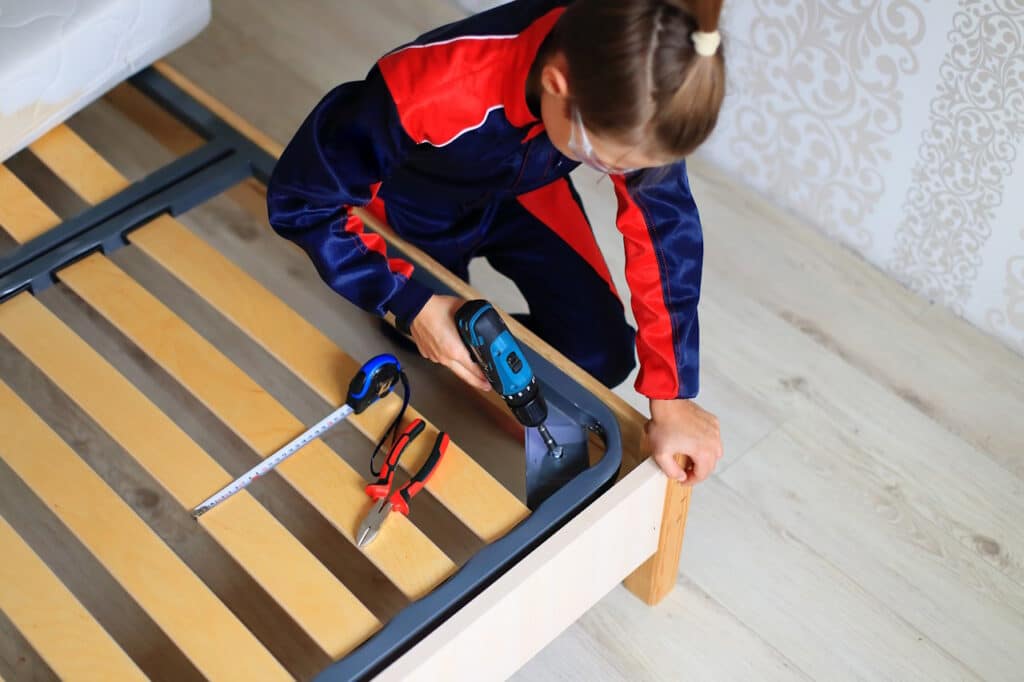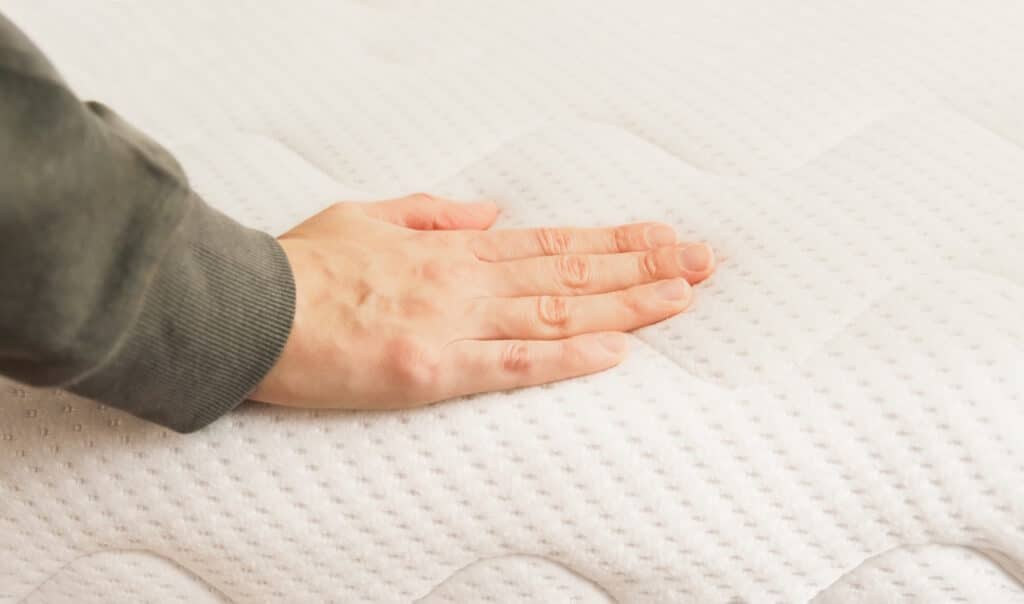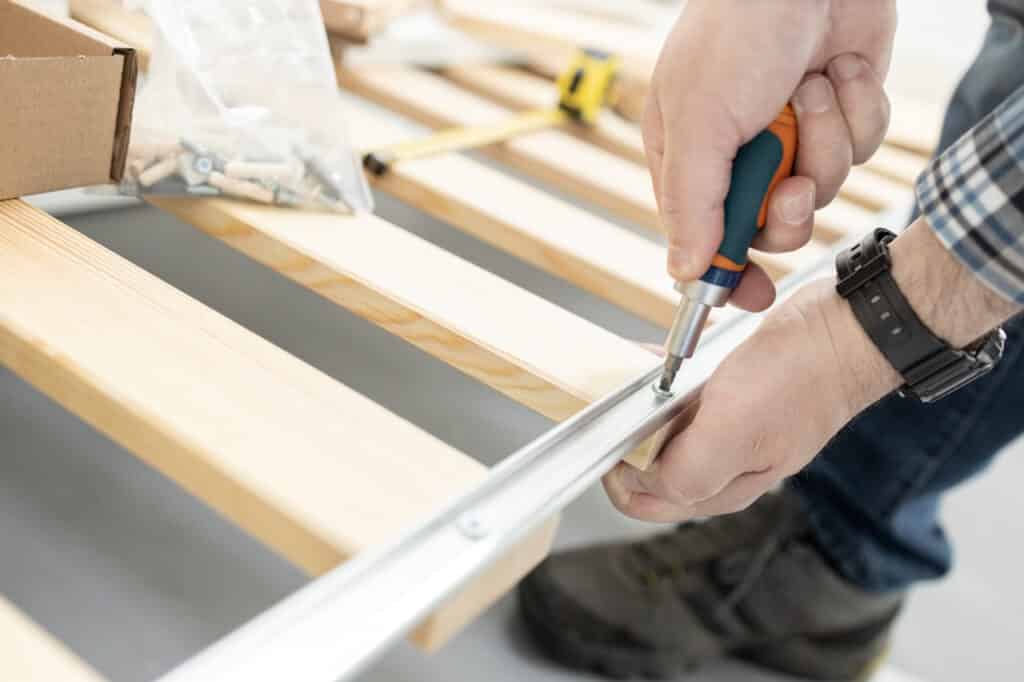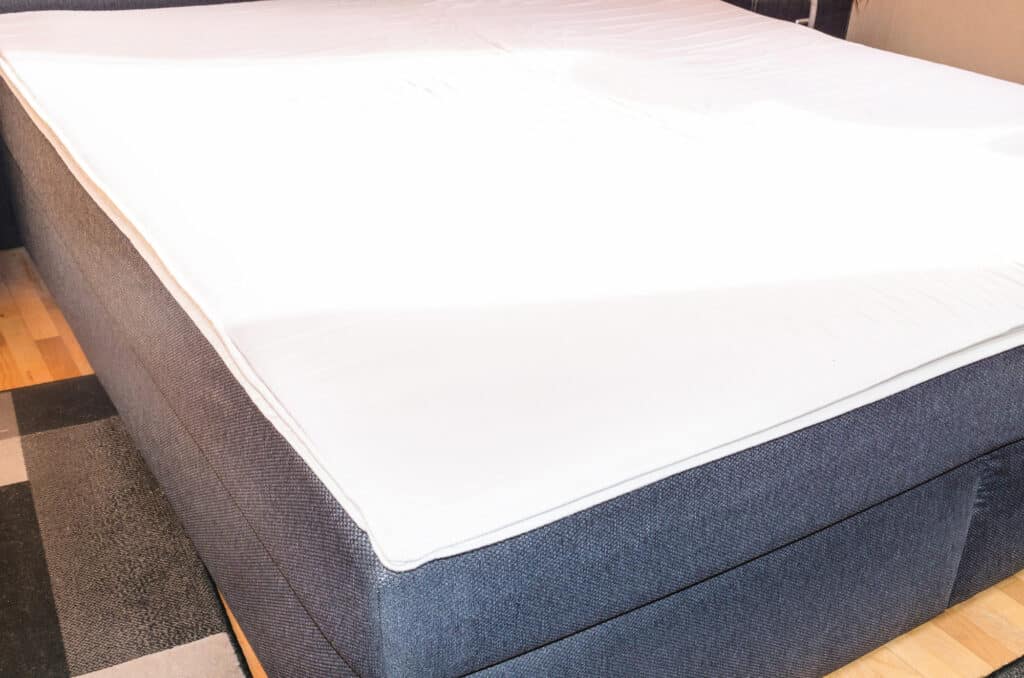Are you tired of your bed’s nightly symphony of squeaks keeping you awake? It’s time to put an end to the noise and finally get the peaceful slumber you deserve.
In this article, we’ll share 16 simple solutions to stop a bed from squeaking so you can finally enjoy a good night’s sleep.
Key Takeaways
- Identify the source of squeaks in your mattress, box spring, or bed frame.
- Try rotating/plywood cushioning for mattresses and lubricating/padding for frames & springs to reduce noise.
- Level legs, use caster cups & upgrade your bed if needed for a quiet sleep!
Identifying the Culprit: Mattress, Box Spring, or Bed Frame?

The first step to fixing a squeaky bed is figuring out which component is causing the noise – the mattress, box spring, or bed frame. By examining each part, you can determine which one needs fixing or replacing, and save yourself the frustration of trying every solution out there.
We will now investigate each component to identify the source of the disturbing squeaks.
Troubleshooting a Squeaky Mattress
Start by examining your mattress. Press on different areas and move around the bed to locate the squeaking noise. If your mattress has metal coils, it’s either an innerspring or a hybrid mattress, which are more likely to cause bed squeaking than foam mattresses.
If you find that your mattress is the culprit and it’s still under warranty, get in touch with the manufacturer. Consider replacing your mattress if the warranty has expired or the innerspring cannot be fixed.
Inspecting a Squeaky Box Spring
Moving on, it’s time to evaluate your box spring. Remove the mattress and press down on the box springs to check if they’re making noise. If you hear squeaking, inspect for loose or worn springs, or any issues with the wooden frame.
Sometimes, the metal coils in a box spring wear down and rub together, causing the squeaking noise. Applying candle wax on wooden bed frames can help reduce friction and squeaking.
Assessing a Squeaky Bed Frame
Lastly, your bed frame needs examination. Check for loose bolts, warped wood, or rubbing joints that may be causing the noise. Give the sides of the bed a shake; if it feels wobbly, you may need to make some adjustments.
If you can’t find any issues with your bed frame, it might be time to consider getting a new one, especially if it’s old or of poor quality.
Remedies for a Squeaky Mattress

If your mattress is the source of the squeaking, try a few solutions to silence it:
- Rotate the mattress
- Place a sheet of plywood underneath it
- Get a mattress topper
- Consider purchasing a new one
These solutions can help reduce noise and make your sleep more peaceful.
We will now delve deeper into these options.
Rotating Your Mattress
Rotating your mattress regularly helps spread out the wear and prevents squeaking in specific areas. It’s recommended to flip your mattress (if it’s not one-sided) every three months to ensure even wear.
This simple maintenance step can prolong the life of your mattress and minimize noise.
Plywood Cushioning
If rotating your mattress doesn’t help, try placing a thin sheet of plywood between the mattress and bed frame. This extra layer can help reduce the pressure on the springs, which may be causing the squeaking noise.
Mattress Topper
Putting a mattress topper on top of your existing mattress is a cost-effective way to reduce the amount of stress on the mattress, providing a cushion between you and the source of the squeaky bed. It might just be all the padding you need to reduce the squeaking and creaking.
Considering a New Mattress
If all else fails, it might be time to invest in a new mattress. Foam and hybrid mattresses are usually quieter than innerspring mattresses.
A new mattress not only eliminates squeaking but also provides improved comfort and support for a better night’s sleep.
Solutions for a Squeaky Bed Frame

If your bed frame is the cause of the squeaking, there are several solutions to fix it:
- Tighten the loose bolts and joints
- Lubricate metal or wooden frames
- Apply wax to wooden frames
- Add fabric or padding to the bed slats.
We will now delve deeper into these methods.
Securing Loose Joints
Loose bolts and joints can cause your bed frame to squeak. Grab a wrench and tighten them up, or add washers between the frame and the bolt if needed.
Ensuring all the joints are secure will help eliminate noise and provide a more stable sleeping surface.
Lubricating the Frame
For metal bed frames, apply a lubricant like WD-40 to reduce friction and noise on your metal bed frame.
For wooden bed frames, apply wax to the frame to minimize friction and squeaking.
Applying lubricant or wax is a simple and effective solution for quieting a noisy bed frame.
Cushioning Bed Slats
Adding fabric or padding to bed slats can help minimize rubbing and squeaking. You can use old socks, T-shirts, felt, or kitchen towels to line the slats and reduce noise.
This simple trick can make a significant difference in the quietness of your bed, and you could even consider it upcycling if you use old materials!
Addressing a Squeaky Box Spring

If your box spring is the cause of the squeaking, try lubricating the springs, adding padding around the box spring, or replacing it with a new foundation or platform bed frame.
Lubricating Box Spring Springs
Apply a lubricant, such as WD-40, to the springs of the box spring to reduce noise. Lubricating the springs not only quiets the squeaking but can also prolong the life of your box spring.
Remember, lubricating the springs should be done with caution.
Padding the Box Spring
Adding padding around the box spring, such as old T-shirts or towels, can help minimize squeaking. Wrap the padding around the box spring and secure it with tape or elastic bands to create a quiet and comfortable sleeping surface.
Considering a New Foundation
If your box spring continues to squeak, consider replacing it with a new foundation or platform bed frame. Many modern mattresses don’t require a box spring and can be placed directly on a platform frame, providing better support and eliminating noise.
Platform bed frames are a great option for those looking to reduce noise and improve support.
Additional Tips for Quieting a Squeaky Bed

In addition to the solutions mentioned above, there are a few more tips to help quiet a squeaky bed:
- Ensure the bed frame legs are level and on even flooring
- Use rubber caster cups under bed frame wheels
- Upgrade to a new bed with a high-quality frame and mattress.
Leveling Bed Frame Legs
Uneven bed frame legs can cause squeaking. Slide a towel or folded sheet under the legs of the bed frame to ensure they are all on the floor, or move the bed to a spot with even floorboards.
This simple adjustment can help eliminate noise and provide a more stable sleeping surface.
Utilizing Caster Cups
If your bed frame has wheels, place rubber caster cups under the wheels to reduce noise caused by squeaky casters. Caster cups are an affordable and easy solution for quieting bed frame wheels and preventing damage to your floors.
Upgrading Your Bed
If all else fails, consider upgrading to a new bed with a high-quality frame and mattress to eliminate bed squeak.
A new bed frame not only solves the noise issue but also provides improved comfort and support for a better night’s sleep.
Summary
Dealing with a squeaky bed can be a frustrating experience, but with these 15 simple solutions, you can say goodbye to sleepless nights. Whether it’s your mattress, box spring, or bed frame causing the noise, these tips and tricks will help you find the right fix and create a quiet, peaceful sleeping environment.
Don’t let a squeaky bed steal your good night’s sleep – take action now and restore the tranquility you deserve.
Frequently Asked Questions
Why does my bed squeak when I move?
The screws and bolts on your bed frame might have come loose, making it squeak when you move. Tighten them up with a screwdriver or wrench, and if that doesn’t work, add some lubrication, or washers to secure the joints.
Why do metal beds squeak so much?
Metal beds can easily squeak due to loose screws and joints, which causes the metal on metal rubbing when there is movement. To fix this, try tightening the joints around the corners of your bed frame with a screwdriver or wrench, lubricating the contact points, or adding washers for extra support.
What’s the first step to fixing a squeaky bed?
To fix a squeaky bed, first identify the source of the squeaking by examining the mattress, box spring, or bed frame. You can tighten nuts and bolts, and apply lubrication or padding to the source of the annoying sound.






